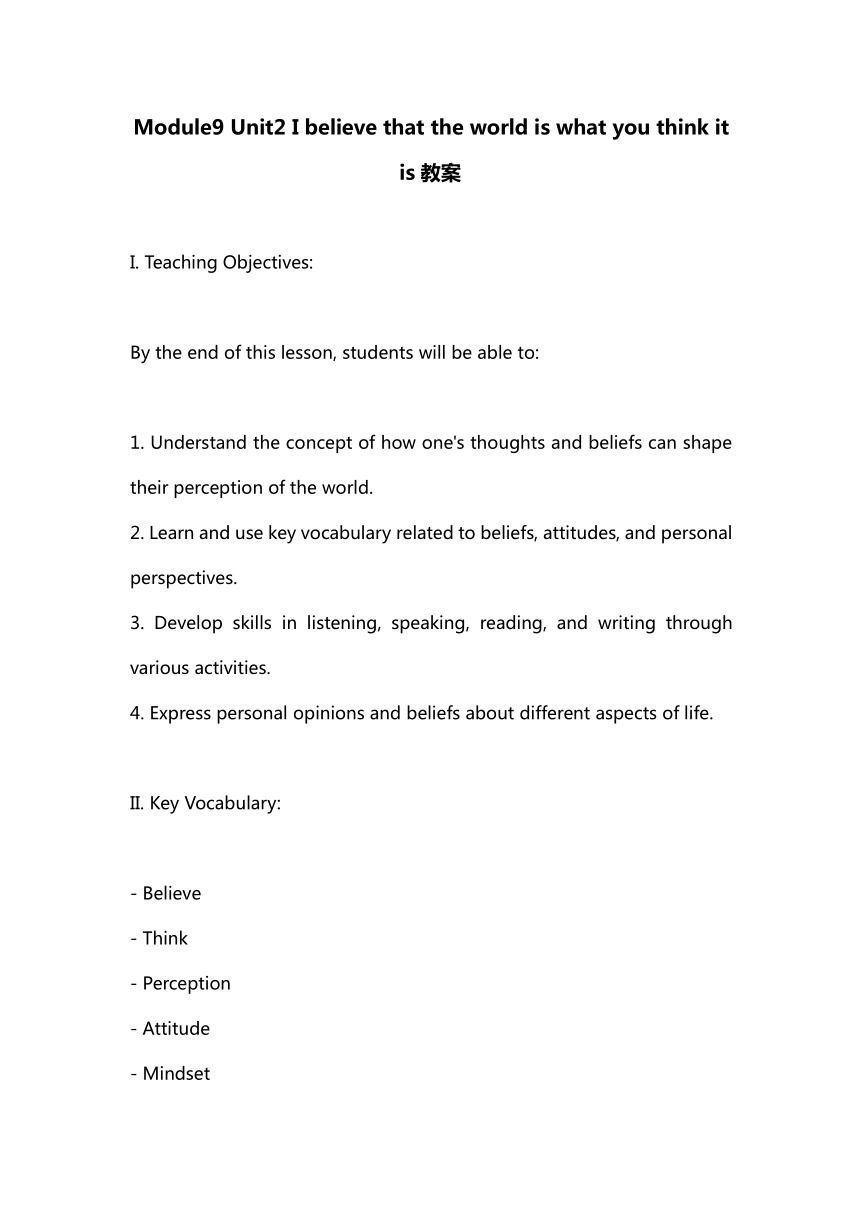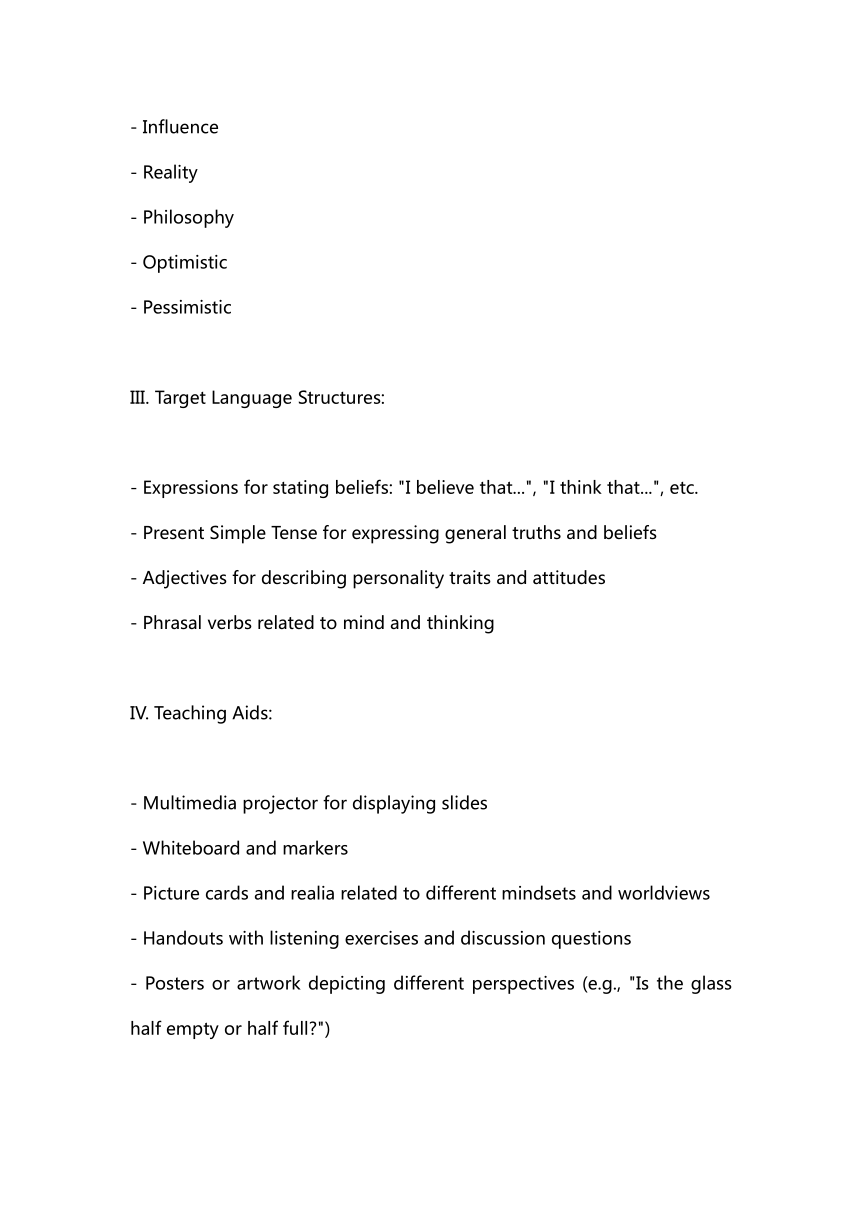外研版八年级下册Module9 Unit2 I believe that the world is what you think it is教案
文档属性
| 名称 | 外研版八年级下册Module9 Unit2 I believe that the world is what you think it is教案 |

|
|
| 格式 | docx | ||
| 文件大小 | 16.9KB | ||
| 资源类型 | 教案 | ||
| 版本资源 | 外研版 | ||
| 科目 | 英语 | ||
| 更新时间 | 2024-02-21 18:35:54 | ||
图片预览


文档简介
Module9 Unit2 I believe that the world is what you think it is教案
I. Teaching Objectives:
By the end of this lesson, students will be able to:
1. Understand the concept of how one's thoughts and beliefs can shape their perception of the world.
2. Learn and use key vocabulary related to beliefs, attitudes, and personal perspectives.
3. Develop skills in listening, speaking, reading, and writing through various activities.
4. Express personal opinions and beliefs about different aspects of life.
II. Key Vocabulary:
- Believe
- Think
- Perception
- Attitude
- Mindset
- Influence
- Reality
- Philosophy
- Optimistic
- Pessimistic
III. Target Language Structures:
- Expressions for stating beliefs: "I believe that...", "I think that...", etc.
- Present Simple Tense for expressing general truths and beliefs
- Adjectives for describing personality traits and attitudes
- Phrasal verbs related to mind and thinking
IV. Teaching Aids:
- Multimedia projector for displaying slides
- Whiteboard and markers
- Picture cards and realia related to different mindsets and worldviews
- Handouts with listening exercises and discussion questions
- Posters or artwork depicting different perspectives (e.g., "Is the glass half empty or half full ")
V. Teaching Procedures:
Step 1: Warm-up (5 minutes)
- Begin the class by asking students what they believe influences a person's outlook on life.
- Elicit vocabulary related to beliefs, attitudes, and perceptions.
Step 2: Pre-reading (5 minutes)
- Show images or posters that illustrate different perspectives on life and have students discuss what they think each one represents using the target language structures.
- Introduce key vocabulary for the lesson and review expressions for stating beliefs and the present simple tense.
Step 3: While-listening (15 minutes)
- Play an audio recording that presents differing views on a particular topic or scenario, emphasizing how beliefs shape reality.
- Ask students to listen and complete the exercises from the handout, focusing on understanding the main ideas and perspectives presented.
- After listening, hold a class discussion to clarify any misunderstandings and deepen comprehension.
Step 4: Post-listening (15 minutes)
- In pairs, students discuss how their own beliefs might affect their daily lives and the way they interact with the world around them using the target language structures.
- Walk around the classroom to provide assistance and encourage accurate use of tenses, vocabulary, and expressions for stating beliefs.
Step 5: Speaking Practice (10 minutes)
- Distribute role-play scenario cards. Each card describes a situation where two people have contrasting beliefs about a particular issue.
- Instruct students to role-play a conversation between two individuals, incorporating the given information and using the target language structures.
- Some pairs can perform their role-play for the class.
Step 6: Writing Task (10 minutes)
- Assign a writing task where students create a short paragraph expressing their own belief about an aspect of life, using the present simple tense and adjectives to describe their attitude.
- Encourage students to reflect on their personal experiences and use descriptive language.
Step 7: Homework & Review (5 minutes)
- Review key vocabulary and language structures by playing a game such as "Mindset Match," where students have to match statements about beliefs with the appropriate image or scenario.
- Assign homework: Students write a short journal entry reflecting on a recent event and how their beliefs may have influenced their experience of it.
VI. Assessment:
- Evaluate students' participation in discussions, listening exercises, and pair work to assess their understanding of vocabulary and ability to use the target language structures.
- Check written assignments for correct use of expressions for stating beliefs, the present simple tense, and adherence to the given scenarios in role-plays.
I. Teaching Objectives:
By the end of this lesson, students will be able to:
1. Understand the concept of how one's thoughts and beliefs can shape their perception of the world.
2. Learn and use key vocabulary related to beliefs, attitudes, and personal perspectives.
3. Develop skills in listening, speaking, reading, and writing through various activities.
4. Express personal opinions and beliefs about different aspects of life.
II. Key Vocabulary:
- Believe
- Think
- Perception
- Attitude
- Mindset
- Influence
- Reality
- Philosophy
- Optimistic
- Pessimistic
III. Target Language Structures:
- Expressions for stating beliefs: "I believe that...", "I think that...", etc.
- Present Simple Tense for expressing general truths and beliefs
- Adjectives for describing personality traits and attitudes
- Phrasal verbs related to mind and thinking
IV. Teaching Aids:
- Multimedia projector for displaying slides
- Whiteboard and markers
- Picture cards and realia related to different mindsets and worldviews
- Handouts with listening exercises and discussion questions
- Posters or artwork depicting different perspectives (e.g., "Is the glass half empty or half full ")
V. Teaching Procedures:
Step 1: Warm-up (5 minutes)
- Begin the class by asking students what they believe influences a person's outlook on life.
- Elicit vocabulary related to beliefs, attitudes, and perceptions.
Step 2: Pre-reading (5 minutes)
- Show images or posters that illustrate different perspectives on life and have students discuss what they think each one represents using the target language structures.
- Introduce key vocabulary for the lesson and review expressions for stating beliefs and the present simple tense.
Step 3: While-listening (15 minutes)
- Play an audio recording that presents differing views on a particular topic or scenario, emphasizing how beliefs shape reality.
- Ask students to listen and complete the exercises from the handout, focusing on understanding the main ideas and perspectives presented.
- After listening, hold a class discussion to clarify any misunderstandings and deepen comprehension.
Step 4: Post-listening (15 minutes)
- In pairs, students discuss how their own beliefs might affect their daily lives and the way they interact with the world around them using the target language structures.
- Walk around the classroom to provide assistance and encourage accurate use of tenses, vocabulary, and expressions for stating beliefs.
Step 5: Speaking Practice (10 minutes)
- Distribute role-play scenario cards. Each card describes a situation where two people have contrasting beliefs about a particular issue.
- Instruct students to role-play a conversation between two individuals, incorporating the given information and using the target language structures.
- Some pairs can perform their role-play for the class.
Step 6: Writing Task (10 minutes)
- Assign a writing task where students create a short paragraph expressing their own belief about an aspect of life, using the present simple tense and adjectives to describe their attitude.
- Encourage students to reflect on their personal experiences and use descriptive language.
Step 7: Homework & Review (5 minutes)
- Review key vocabulary and language structures by playing a game such as "Mindset Match," where students have to match statements about beliefs with the appropriate image or scenario.
- Assign homework: Students write a short journal entry reflecting on a recent event and how their beliefs may have influenced their experience of it.
VI. Assessment:
- Evaluate students' participation in discussions, listening exercises, and pair work to assess their understanding of vocabulary and ability to use the target language structures.
- Check written assignments for correct use of expressions for stating beliefs, the present simple tense, and adherence to the given scenarios in role-plays.
同课章节目录
- Module 1 Feelings and impressions
- Unit 1 It smells delicious.
- Unit 2 I feel nervous when I speak Chinese .
- Unit 3 Language in use
- Module 2 Experiences
- Unit 1 I've also entered lots of speaking competi
- Unit 2 They have seen the Pyramids.
- Unit 3 Language in use
- Module 3 Journey to space
- Unit 1 Has it arrived yet?
- Unit 2 We have not found life on any other planet
- Unit 3 Language in use
- Module 4 Seeing the docto
- Unit 1 I haven't done much exercise since I got m
- Unit 2 We have played football for a year now
- Unit 3 Language in use
- Module 5 Cartoons
- Unit 1 It's time to watch a cartoon.
- Unit 2 Tintin has been popular for over eighty yea
- Unit 3 Language in use
- Revision module A
- Module 6 Hobbies
- Unit 1 Do you collect anything ?
- Unit 2 Hobbies can make you grow as a person.
- Unit 3 Language in use
- Module 7 Summer in Los Angeles
- Unit 1 Please write to me and send me some photos
- Unit 2 Fill out a form and come to learn English
- Unit 3 Language in use
- Module 8 Time off
- Unit 1 I can hardly believe we are in the city ce
- Unit 2 We thought somebody was moving about
- Unit 3 Language in use
- Module 9 Friendship
- Unit 1 Could I ask if you've mentioned this to he
- Unit 2 I believe that the world is what you think
- Unit 3 Language in use
- Module 10 On the radio
- Unit 1 I hope that you can join us one day
- Unit 2 It seemed that they were speaking to me in
- Unit 3 Language in use
- Revision module B
